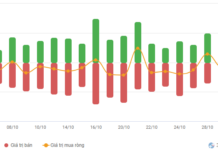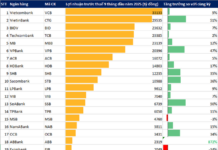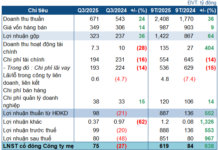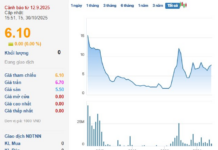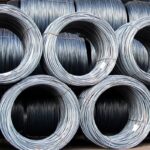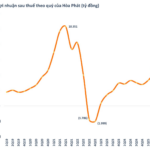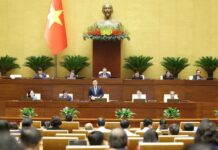
Workers of La Hien Joint Stock Company – VVMI Cement loading cement for customers. (Photo: Hoang Nguyen/VNA)
|
Since the beginning of the year, the prices of key construction materials such as steel, cement, sand, and stones have surged, causing significant repercussions on the progress and financial capabilities of numerous construction projects nationwide.
According to statistics from the Ministry of Construction, steel prices have risen by an average of 12-15% compared to the same period in 2024, while cement prices have increased by 8-10%. Sand prices have surged by over 20% in high-demand areas such as Ho Chi Minh City, Hanoi, and Binh Duong.
This price hike has led to a significant increase in input costs for construction projects, directly affecting their progress and capital disbursement plans.
The rapid and unstable increase in construction material prices is causing difficulties for investors and construction contractors in terms of financial management and project implementation according to the initial plans. Many contracts have had to adjust their timelines or even temporarily halt work pending updated prices.
Mr. Nguyen Van Hung, director of a construction company in Hanoi, stated that construction costs have risen by about 15-20% compared to the initial estimates. Without a price adjustment mechanism or timely support, it will be challenging for companies to complete the projects on time. This situation particularly affects projects using state budget and public investment capital.
Some localities have also reported that due to the slow adjustment of unit prices, many projects have been delayed by 1-3 months, affecting capital disbursement plans and the efficiency of capital use.
Facing this situation, the Ministry of Construction has requested local authorities to promptly update construction price indices and strengthen the management of the construction material market to prevent speculation and price manipulation. The Ministry of Finance is also coordinating and studying a mechanism to adjust estimates to match market price fluctuations.
Experts predict that if construction material prices remain high or continue to rise in the last months of the year, many key projects may have to extend their timelines, affecting the country’s infrastructure development, investment attraction, and economic growth.
According to experts, there are several main reasons for the sharp increase in brick prices and construction material prices in general in Vietnam recently. Firstly, input costs have risen sharply.
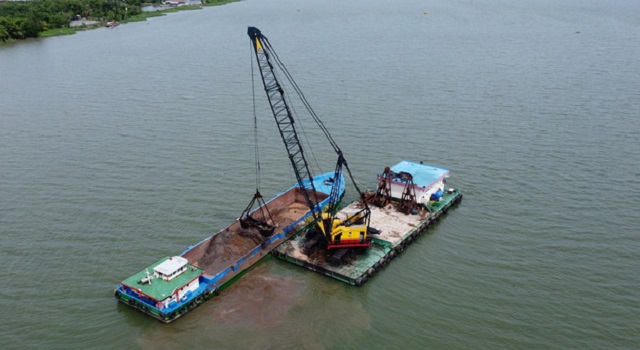
Sand mining. (Source: VNA)
|
The prices of raw materials such as sand, stones, coal, lignite, and clay have escalated: sand prices have increased by about 10% compared to the end of 2024 (VND 140,000-400,000/m3), and stones and coal have also risen sharply. The price of lignite used for brick firing has increased by 40–50% compared to the previous year.
Additionally, energy and transportation costs are soaring. The increase in oil, electricity, and gas prices (affecting cement and fired brick production) has led to a significant rise in transportation costs for construction materials.
In remote areas such as Dak Nong, transportation costs for sand have doubled or tripled due to the long distance, while supply is limited.
Environmental protection regulations have tightened sand, stone, and clay mining, with some mines having to cease operations. Natural disasters such as typhoons and floods (e.g., after Typhoon Yagi) have also reduced the capacity or halted operations of many brick factories. Meanwhile, the demand for traditional fired bricks remains high, while the supply has slightly decreased.
Another factor is the surge in “demand” from public investment and the real estate market. Since the beginning of 2025, numerous key infrastructure, social housing, and transport projects have been launched, leading to a “surge” in demand for construction materials.
The real estate market has recovered after the amendments to the Land Law, Housing Law, and Law on Real Estate Business, along with expanded public investment, causing total demand to far exceed supply.
Market speculation, hoarding, and price manipulation have also had a significant impact. Some areas, such as Da Nang, have witnessed instances of sand and brick hoarding, leading to unreasonable price hikes. The situation has become so severe that the Prime Minister had to intervene and instruct the police to investigate and handle the market manipulation.
Specifically, in Official Dispatch No. 85/CD-TTg on strengthening solutions to manage and stabilize construction material prices, Prime Minister Pham Minh Chinh assigned the Minister of Construction to promptly review, guide, and direct local authorities to assess and synthesize the demand for construction materials in their respective areas.
In collaboration with the Ministry of Agriculture and Environment, the Ministry of Construction will guide and direct local authorities in planning, identifying mines, sources, capacity, and supply to ensure a balance between supply and demand, promptly handling any difficulties and obstacles, especially the local and national supply-demand imbalance.
Meanwhile, the Minister of Industry and Trade was assigned to direct market management agencies to strengthen inspections, promptly detect and handle acts of hoarding, price gouging, and unreasonable price increases; and strictly handle construction materials of unknown origin, counterfeit, or inferior quality.
The Minister of Public Security was assigned to coordinate with relevant agencies to investigate and strictly handle organizations and individuals that manipulate the market, hoard goods for profit in the production and trading of construction materials, and those who cover up, protect, or neglect to promptly and thoroughly handle violations.
Moreover, disruptions in the global supply chain, such as international logistics interruptions and rising freight rates due to the oil crisis and geopolitical tensions, have contributed to higher import costs for raw materials.
Along with the impact of weather factors such as storms and floods, which can disrupt brick production and transportation, leading to shortages and higher prices, psychological factors have also played a role.
The recovery of the real estate market and the tendency of people to build and repair houses have created a psychology of buying more bricks, contributing to the increase in brick prices and construction material prices in general.
In Son La province, many projects, businesses, and individuals are facing challenges due to high prices and local supply shortages, affecting their plans and construction progress, as well as incurring many unnecessary costs.
Mr. Dao Tai Tue, Director of the Son La Department of Construction, shared that, overall, the supply of construction materials in the province still basically meets the demand. However, the main cause of the local shortage is the low licensing rate for mineral exploitation.
Currently, only 38 out of 162 mines have been licensed for exploitation and are operating, accounting for a mere 23% of the approved plan. This rate has caused an imbalance between supply and demand, especially for filling soil, stones, and sand in some localities.
According to Mr. Tue, the current procedure for licensing mineral exploitation for common construction materials involves multiple steps and takes a long time, causing difficulties for businesses and delaying the operation of mines. These are significant challenges faced by both state management agencies and businesses.
 Hot-rolled coil (HRC) steel is the main product of Hoa Phat Dung Quat Steel Plant in Quang Ngai province, widely used domestically and exported. (Photo: Quoc Khanh/VNA)
|
Similarly, the Hanoi People’s Committee has sent Document No. 3873/UBND-DT to the Ministry of Construction, requesting early guidance on survey methods and price adjustments to remove difficulties for public investment projects.
A practical investigation shows that, since the second quarter of 2025, the prices of key construction materials such as steel, cement, sand, and stones have simultaneously increased sharply, with some items rising by 15-25% compared to the beginning of the year.
The market has also recorded a shortage of construction sand in many northern regions, forcing contractors to stop construction or adjust the progress.
In some key projects in Hanoi, such as the Ring Road 4, West Lake improvement project, and the road connecting Gia Lam and Dong Anh districts, many packages have been severely affected. Some contractors reflected that the estimates made at the beginning of 2024 are no longer suitable for the current market prices, leading to the risk of heavy losses or even abandonment of the project – as quoted by the Hanoi People’s Committee.
Construction experts warn that if material prices continue to rise uncontrollably and there is no mechanism to update prices promptly, public investment projects will not only be delayed but also affect capital disbursement, thereby hindering local economic growth.
The issue of rising construction material prices is not just a technical problem but also a policy challenge that requires swift action from both central and local authorities.
If timely responses are not provided to the proposals, such as Hanoi’s, many public projects will fall into a “stalemate,” which is unacceptable in the current sprint for public investment disbursement./.
– 09:02 05/09/2025
Unveiling a Revolutionary Strategy to Combat Speculation and Profiteering in Construction Material Prices
In the midst of soaring construction material prices, it is imperative for the government to establish a centralized national website platform to regulate and disseminate information on construction material, equipment, labor, and machinery prices.
The National Construction Price Index Rises Again in 2024, Up 0.24% from 2023
The Ministry of Construction has reported a positive trend in the national construction cost index for 2024, reflecting a 0.24% increase compared to 2023 and a significant 15.35% rise since 2020.


